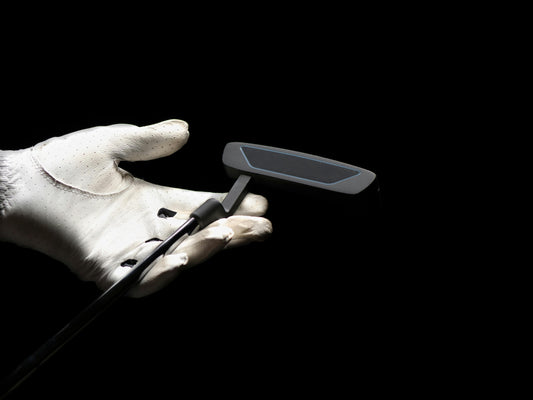Let me tell you something about putting—it's perhaps the most personal aspect of golf. After nearly 30 years working in the game and 16 as a PGA Professional, who has worked with thousands of golfers, I've seen firsthand how the right putter can transform someone's game.
If you're in the market for a new putter or considering an upgrade, understanding the different types is crucial. I'll walk you through everything you need to know to make the right choice.
The Two Main Putter Categories (And Their Secret Hybrid)
When we talk about putters, most fall into two primary categories: mallet or blade style. But there's also a third option that combines elements of both.

Mallet Putters: Forgiveness Is Your Friend
Mallet putters feature larger heads that come in various shapes—round, square, or semi-circular (sometimes called half-moon designs). The beauty of a mallet is how it distributes weight across a larger area, creating a more generous sweet spot.
I typically recommend mallets to newer golfers because they're more forgiving on off-center hits. But here's something interesting: nearly 70% of PGA Tour players now use mallet putters. The forgiveness factor has made them increasingly popular even among elite players.
The larger head size also allows for more alignment aids, which can help square the face at address and improve your aim. If you struggle with consistent contact or alignment, a mallet might be your best bet.
Blade Putters: Classic Design With Precision Feel
When most people picture a traditional putter, they're thinking of a blade. These feature a simple, rectangular head design with either a narrow or non-existent flange (the back cavity area).
In my experience, better putters often gravitate toward blades because of their clean, symmetrical shape and enhanced feedback. They typically offer better feel and control for players who consistently strike the ball in the center of the face.
I've noticed that blade putters tend to work better for players with an arcing putting stroke. If you naturally take the putter slightly inside on the backstroke and return it to square at impact, a blade might complement your stroke.
Half-Mallet Putters: The Best of Both Worlds

The half-mallet, also known as a combination putter, blends elements of both designs. It maintains some of the traditional look of a blade but incorporates a modified, smaller mallet design in the back.
I've fit many players into half-mallets when they like the look of a blade but need a bit more forgiveness. They're an excellent middle ground that's becoming increasingly popular.
Putter Faces: Insert vs. Milled
Beyond the head shape, the face construction significantly impacts feel and performance.

Insert Faces: Customized Feel
Insert putters have a different material inlaid into the face. Typically metal, plastic, urethane, or rubber. This design allows manufacturers to create specific feel characteristics.
I've found that insert faces can help newer golfers who haven't yet developed a consistent feel. The insert can provide a softer impact sensation and more consistent roll, even on mishits.
Some of my students worry that insert putters are only for beginners, but that's simply not true. Tiger Woods won multiple majors with a Teryllium insert in his Scotty Cameron, and many tour pros still use insert-faced putters today.
Milled Faces: Precision and Feedback
A milled putter is crafted from a single piece of metal (usually aluminum or carbon steel) with the face precisely milled by a CNC machine. This creates a consistent, uniform surface across the entire face.
In my teaching experience, better players often prefer milled faces because they provide more direct feedback. You'll feel exactly where you struck the ball, which helps develop consistency over time.
The downside? Milled putters are generally more expensive. But if you practice regularly and value precise feedback, the investment might be worthwhile.
Shaft Placement: Center vs. Heel
Where the shaft connects to the putter head affects how the putter performs during your stroke.
Center-Shafted Design
With a center-shafted putter, the shaft connects directly to the middle of the putter head. This design typically helps golfers who prefer a straight-back, straight-through putting stroke.
I've found that center-shafted putters can help players who struggle with directional consistency. Most center-shafted putters are face-balanced, which minimizes face rotation during the stroke—perfect if you tend to pull or push your putts.
Heel-Shafted Design
In a heel-shafted putter, the shaft connects near the heel of the putter head. This design works better for golfers with an arcing stroke.
When I'm fitting players who naturally have some arc in their putting stroke, I often recommend heel-shafted putters. They're typically toe-balanced, which means they naturally rotate during the stroke, helping you square the face at impact.
Neck Designs: More Than Just Aesthetics

The neck (or hosel) design affects how the putter performs and feels. Here are the main types:
Flow Neck
A flow neck has a smooth, flowing transition from shaft to head. This design is ideal for players with significant face rotation through the stroke.
If you tend to leave the face open at impact, a flow neck might help. It has less offset and promotes more toe rotation, helping close the face through impact.
Plumber's Neck
Named for its resemblance to plumbing pipes, this design features a horizontal "L" bend in the hosel. It works well for players with moderate face rotation.
I've fit many players into plumber's neck putters because they offer a middle ground—some toe weighting but not as much as a flow neck. They're versatile and work for a variety of stroke types.
Single Bend vs. Double Bend
Single-bend necks have one slight bend just above where the shaft meets the head. They're face-balanced and ideal for straight-back, straight-through strokes.
Double-bend necks have two slight bends and offer even more forgiveness with higher MOI (moment of inertia). In my teaching, I've found these particularly helpful for players who struggle with consistency.
Putter Weighting: Balance Matters
How weight is distributed throughout the putter head affects how it performs during your stroke.
Toe Weighted
A toe-weighted (or toe-hung) putter has extra weight in the toe section. You can check this by balancing the shaft on your finger—if the toe points downward, it's toe-weighted.
This design is perfect for players with an arcing stroke. The toe weight helps the face naturally rotate open on the backstroke and closed through impact.
Face-Balanced
In a face-balanced putter, the weight is evenly distributed between the heel and toe. When balanced on your finger, the face will point upward toward the sky.
I recommend face-balanced putters to players with a straight-back, straight-through stroke. The balanced weighting minimizes face rotation, helping keep the putter square throughout the stroke.
Finding Your Ideal Putter Length
Putter length is critical but often overlooked. Standard putters range from 32" to 36", but finding the right length for your height and setup is essential.
Here's a general guideline based on height:
| Height |
Putter Length |
|
6'4" + |
36 inches |
| 6'2" to 6'4" |
35.5 inches |
| 6'0" to 6'2" | 35 inches |
| 5'8" to 6'0" | 34.5 inches |
| 5'6" to 5'8" | 34 inches |
| 5'4" to 5'6" | 33.5 inches |
|
5'2" to 5'4" |
33 inches |
| 5'0" to 5'2" | 32.5 inches |
| Below 5'0" | 32 inches or shorter |
That said, personal comfort trumps guidelines. I'm 6'0" tall, but I use a 32.5" putter because I prefer my arms hanging straight down with the grip in the middle of my top hand. It's all about what feels right to you.
Long Putters and Arm-Lock Options
Long putters (40-42 inches) have made a comeback with the popularity of arm-lock putting. This style anchors the grip against your forearm, reducing hand manipulation during the stroke.
In my coaching, I've found arm-lock putting particularly helpful for players who get nervous or experience the yips. By minimizing wrist action, it can create a more consistent, repeatable stroke.
Grip Size: A Critical Factor
| Putter Grip | Diameter | Ideal For | Putter Example |
|---|---|---|---|
| Standard Putter Grip | Approx. 1.00 inches (25.4 mm) | Golfers with smaller hands or those who prefer more wrist action during the stroke | TaylorMade Ghost Tour Standard Putter Grip |
| Midsize Putter Grip | Approx. 1.20 inches (30.5 mm) | Players seeking a balance between control and feel, often with medium-sized hands | NO1 P60 Straight Midsize Putter Grip |
| Jumbo Putter Grip | Approx. 1.30 inches (33 mm) | Golfers with larger hands or those looking to minimize wrist movement for a more stable stroke | JumboMax Mid-Jumbo Putter Grip |
| Super Jumbo Putter Grip | Up to 1.75 inches (44.45 mm) | Players desiring maximum stability and reduced hand action, often beneficial for arthritis or large hands | SuperStroke Fatso 5.0 Putter Grip |
The grip size affects how your hands interact with the putter and can significantly impact your stroke.
Standard grips are the traditional size, while midsize and oversized grips progressively increase in diameter.
I've seen many players improve dramatically by simply changing grip size. As a general rule, a larger grip tends to quiet the hands and reduce face rotation—helpful if you tend to pull putts left (for right-handed golfers). Conversely, a smaller grip can increase face rotation, which might help if you leave putts out to the right.
How to Determine Which Putter Is Right for You
After fitting countless players for putters, here's my process for finding your perfect match:
1. Record your current putting stroke from face-on and down-the-line angles
2. Capture slow-motion footage focusing on the putter head
3. Analyze what your putter face is doing at impact
Look for patterns in your stroke. Do you naturally arc the putter? Does your face stay square? Do you consistently hit the sweet spot?
Understanding your tendencies will help narrow down which features will benefit your game most. If you're serious about improving, consider a professional putter fitting. With putting accounting for roughly 40% of your shots during a round, it's one of the best investments you can make.
Final Thoughts
After decades in the golf industry, I've learned that putting is deeply personal. What works for one player might be completely wrong for another.
The best putter for you combines the right physical characteristics with the intangible element of confidence. When you stand over a putt with complete trust in your equipment, magic happens.
Whether you choose a mallet for forgiveness, a blade for feel, or something in between, make sure it suits your eye and your stroke. Take time to experiment with different options, and don't be afraid to go against conventional wisdom if something unconventional feels right to you.
Remember, the perfect putter isn't necessarily the most expensive or the one your favorite pro uses—it's the one that helps you hole more putts. And at the end of the day, that's all that matters.





